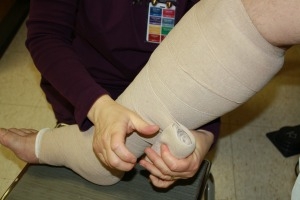Lymphedema
 Lymphedema is an accumulation of protein-rich fluid that occurs because of a malfunctioning lymphatic system. Lymphedema typically causes swelling of the arm(s), leg(s), trunk or head/neck.
Lymphedema is an accumulation of protein-rich fluid that occurs because of a malfunctioning lymphatic system. Lymphedema typically causes swelling of the arm(s), leg(s), trunk or head/neck.
If lymphedema is untreated, risk of infection increases second to stagnant proteins. Primary lymphedema is caused by an abnormality of the lymphatic system itself.
Secondary lymphedema can result from surgical removal of lymph nodes, from radiation therapy, from trauma to the lymphatic system and from other medical conditions that affect the circulatory or lymphatic system.
Following surgery, lymphedema may be noted immediately, or it may not develop for years.
Who would benefit/What’s in it for me?
Patients should see an OT (occupational therapist) or a PT (physical therapist) lymphedema specialist if they have:
- Been diagnosed with primary lymphedema
- Been diagnosed with any of the following types of cancer: breast, gynecological or prostate and have discussed referral with medical provider.
- Swelling due to a post-surgical or post-traumatic injury
- Chronic venous insufficiencies
- Chronic arm or leg swelling
What to expect
Initial visit will be an evaluation and last about 60 minutes. Evaluation is complete to determine level of lymphedema, range of motion and strength deficits, functional difficulties and personal goals.
Individualized plan of care is determined and may include:
Manual Lymph Drainage (MLD)
This specialized form of manual therapy is utilized to stimulate the lymph system to promote lymph drainage.
Multi-Layered Compression Bandaging
Bandaging of the affected limb(s) using appropriate stretch bandages will follow MLD treatment. Compression bandaging and self-wrapping are taught to promote swelling reduction. Upon swelling reduction, patients will use compression garments to maintain reduced limb size.
Exercise
An individualized exercise program is given based upon the patient’s deficits for strengthening, flexibility and endurance to help promote lymph flow and drainage. A home program is established and should be continued following discharge from lymphedema rehabilitation as outlined by treating clinician.
Skin Care
Treatment includes instruction in skin care. Lymphedema is a drying condition, and it is essential the skin in maintained in good condition to decrease the risk of infection.
Goals of lymphedema treatment are to reduce swelling to enable performance of daily living, return to work and leisure activities, improve function of affected limb, decrease risk of infection, enhance self-esteem and body image and obtain compression garments that will manage edema long term.
How to Get Started
Physician’s referral is needed to set up an initial evaluation appointment.
What to Bring
Please bring your insurance card and a photo ID. Please wear comfortable clothing and shoes. Bring any compression garments that you are currently using.
When to Arrive
Arrive 15 minutes prior to your scheduled visit to complete your registration process. For children under the age of 18, a parent or guardian must be present for the initial appointment.